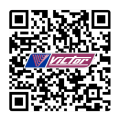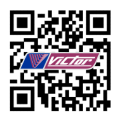

Application
All categories
What is a real "industrial robot" - [Victor] takes you to interpret
Release time:
2019/03/14
[Victor] leads you to understand the definition of industrial robots!
Industrial robots are multi-joint robots or multi-degree-of-freedom robots for industrial applications. An industrial robot is a machine that performs work automatically, and is a machine that realizes various functions by its own power and control ability. It can be commanded by humans or run in accordance with pre-programmed procedures, and modern industrial robots can also act according to the principles of artificial intelligence.
Industrial robots consist of three basic parts: the main body, the drive system and the control system. The main body is the base and the actuator, including the arm, the wrist and the hand, and some robots and walking mechanisms. Most industrial robots have 3 to 6 degrees of freedom of movement, of which the wrist usually has 1 to 3 degrees of freedom of motion; the drive system includes a power unit and a transmission mechanism for the actuator to generate corresponding actions; the control system is input according to the input. The program signals and controls the drive system and the actuator.
Industrial robots are divided into four types according to the movement of the arms. The rectangular coordinate type arm can move along three orthogonal coordinate coordinates; the cylindrical coordinate type arm can be used for lifting, turning and telescopic movement; the spherical coordinate type arm can be rotated, pitched and telescopic; the articulated arm has multiple Rotate the joint.
The industrial robot is controlled by the movement of the actuator, and can be divided into a point type and a continuous track type. The point type only controls the accurate positioning of the actuator from one point to another, and is suitable for machine loading and unloading, spot welding and general handling, loading and unloading operations; continuous track type control actuator can move according to a given trajectory, suitable for continuous welding and Painting and other operations.
Industrial robots with tactile, force or simple vision can work in more complex environments; if they have recognition functions or further increase adaptive, self-learning functions, they become intelligent industrial robots. It can adapt to the environment according to the "macro" selection or self-programming given by people, and automatically complete more complicated work.
Industrial robots can replace some people in industrial production for some monotonous, frequent and repeated long-term operations, or work in dangerous and harsh environments, such as stamping, pressure casting, heat treatment, welding, painting, plastic molding, In the process of machining and simple assembly, as well as in the atomic energy industry and other departments, the handling or process operation of hazardous materials for human body is completed.
Because industrial robots have certain versatility and adaptability, they can adapt to the production of many varieties of medium and small batches. Since the 1970s, they have often been combined with digital control machine tools to become part of flexible manufacturing units or flexible manufacturing systems
WeChat public number: Wittel robot
For more real-time information, please pay attention: Wittel - official website
Website: www.victorsz.net
Contact number: 0755-89260979
Address: No. 61, Huancheng South Road, Pingdi Street, Longgang District, Shenzhen
Long press the bottom left corner QR code "recognition" attention






